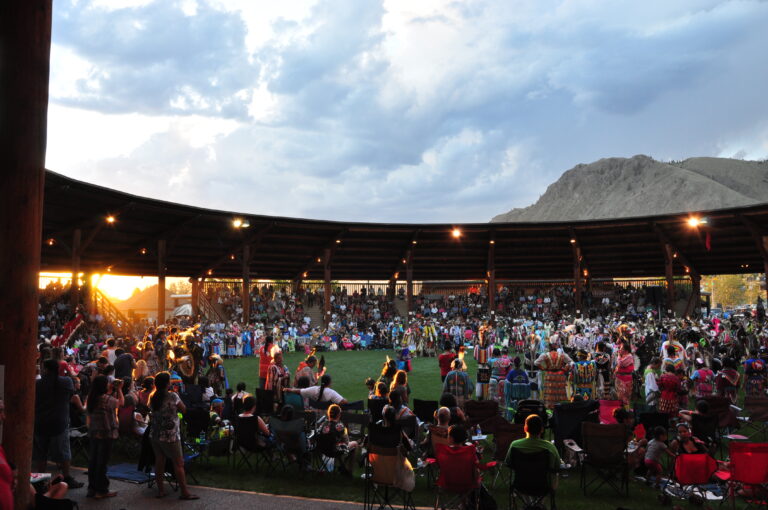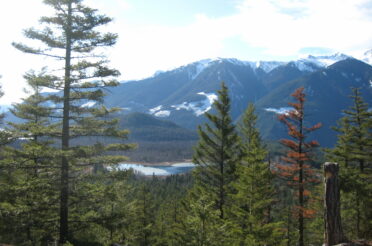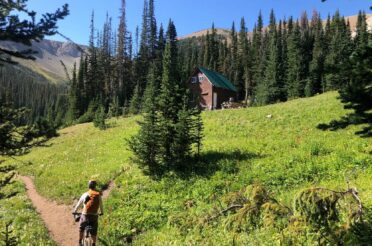Kamloops Pow-Wow

The Kamloops Pow-Wow, held in Kamloops, BC annually, would be a whole group outing for the Chilcotin Holidays team. Fourteen of us piled into three trucks early Friday morning for the four hour drive from the ranch to Kamloops. We made it to the Pow-Wow, ready to experience this huge native culture festival.
The Pow-Wow celebrates First Nations culture through expressive dance and song, with people attending from much of Western Canada and the United States. Over a thousand dancers, dressed in traditional costume, participated over the long weekend. This Pow-Wow celebrates Secwepemc heritage and the circle was crowded with dancers and spectators. Circles are so important to First Nations people as they symbolize the cycles of nature, the sun, moon and fire, including the cycle of life and the transition from this life onto the next. At the Pow-Wow, the dance area was a circle, the bleachers were arranged in a second circle around the dancers.
The main event was the dancing, but before this started, we toured the stalls below the bleachers of the dancing circle selling handmade crafts. Some of the crafts on sale included knives made from antlers with blades of jet, opal and other stones. The seller made these all by hand, some from antlers found in the area, others from animals he had hunted. He also sold ear-rings made from porcupine quills. He explained he had found three or four of the animals as road kill and honoured them by making jewelry from them.
We found paintings of animals with a description of their place within native culture. The wolf symbolizes teamwork as the lone wolf cannot survive for long. The bear symbolizes power and courage, strength and leadership. Warriors would wear bear claws as a sign of protection. Eagles are a symbol of wisdom, with a direct connection to the creator. As they mate for life, they are a symbol of dedication and lasting love. Loons are a symbol of tranquility and the power of dreams.
Another stall sold wooden engravings. Some were animals, others featured quotes on a piece of wood shaped like a feather. The quote which spoke the most to me was from the Dakota tribe. It read ‘We will be known by the tracks we leave behind’ and complemented our ranch philosophy. Another quote which fitted with our philosophy talked of team work, it read ‘Don’t walk behind me, I may not lead, don’t walk in front of me, I may not follow, just walk beside me and be my friend.’ This spoke of our group-ethic and egalitarian culture at the ranch.
After buying some refreshing real lemonade from one of the food stalls, we headed into the circle for the drum call. Here, groups of seven or eight were arranged around the dancing circle, each group was a First Nations community. The groups took it in turns to drum a song; all members of the group hit the same drum, each using one stick. They sung as they drummed, the drumming is the heartbeat of of the Pow-Wow and something which is universal across the nations. These songs tell stories. The Sioux Nation have a series of songs which narrate the Battle of the Little Big Horn, from defending the women and children to fighting Custer. The flag song, equivalent to a national anthem, is also played and sung with drumming. There are three drumbeats – honour, round dance and straight beat – which adds layers of complexity to the song.
After the roll call, the drum circle drummed for the Grand Entry, where all the dancers who would be performing and the attending dignitaries entered the circle. The dancers wore elaborate clothing and head wear which included a lot of bright colours and feathers. The type of dance they would be performing dictated their clothing, therefore those who would be dancing the chicken dance wore a circle of feathers like a tail on their backs.
At first, we watched the dancers, but between each group of dances, the spectators could join the dance. We were all moved by the emotion and excitement of the music, the drum beats thumping like a second heart against our ribs. We climbed down the bleachers to join the dancing. Here, we followed the lead of those already dancing, moving around the circle in a clockwise direction instead of standing in one spot as I would normally do when dancing. We made a few rotations of the circle, where we were thoroughly engaged in the dancing and the atmosphere. We could feel the power of the music and the dancers, it was moving to be a part of.
We bought dinner from the food stands, one of which served bannock and was by far the most popular. Bannock is a traditional First Nations dish, a type of bread, popularly thought to have been introduced to the natives by Scottish fur traders in the early 18th and 19th centuries. However, First Nations people did eat this dish before European contact. The flour they used was made from lichen and plants and the dish incorporated other ingredients not used by Europeans. At the ranch, bannock, or Indian bread, is a mainstay of our weekly wild harvest dinner.
We brought our meals back to the bleachers to watch the next group of dancers. In addition to the chicken dance, the dancers imitated other animals. As we watched, we could see the differences between the girls, boys, men and women who danced in different categories. One of the women’s categories was the jingle dance. This originated when a medicine man’s granddaughter became sick. His spirit guides told him in a dream that if she danced in a jingle dress, she would be healed. As such, it is seen to bring healing.
In contrast, the men’s fancy dance is a war dance. Their costumes are usually bigger with more feathers, although men’s and women’s clothes are equally colourful. The dances take a long time to perfect, we could see this through the differences in technique between the children’s and adults’ dances.
This celebration continued into the night, the Pow-Pow would last across the long weekend, with more dancing and drumming. For all of us interns, this was a first time experience and one we sure wouldn’t forget, we were all touched by the power of the music and the spirit of the dancers. It was truly special to be a part of this event, seeing the First Nations communities determined to keep their culture alive and strong. The dancers and spectators were almost entirely First Nations, our Chilcotin Holidays crew seemed to make up the majority of the non-native attendees. It was empowering to see the presence and importance of the First Nations in Canada.
Zoey



